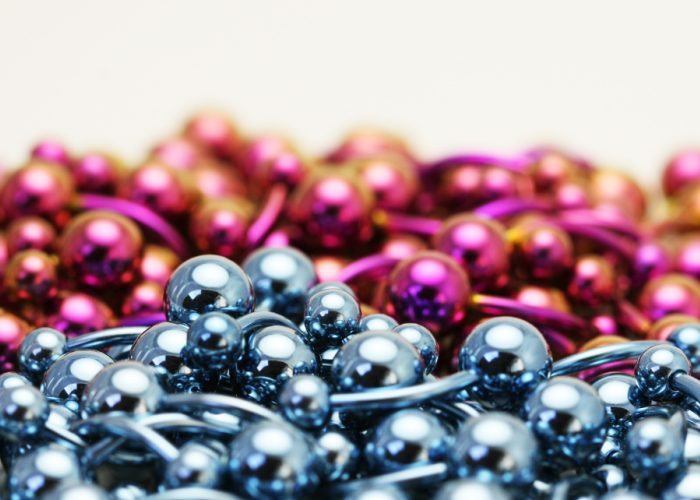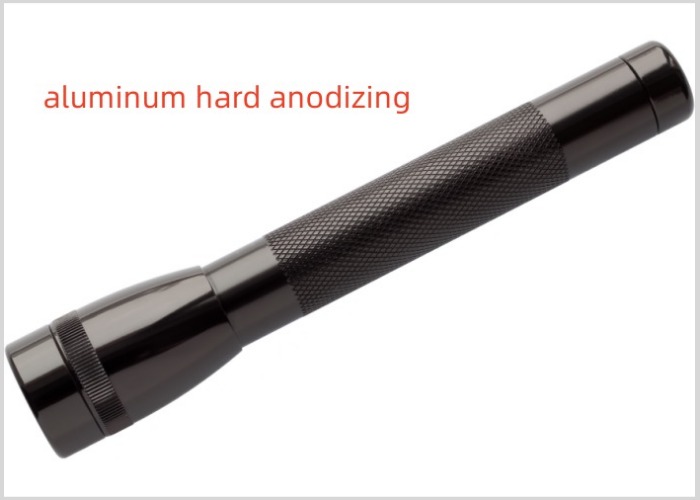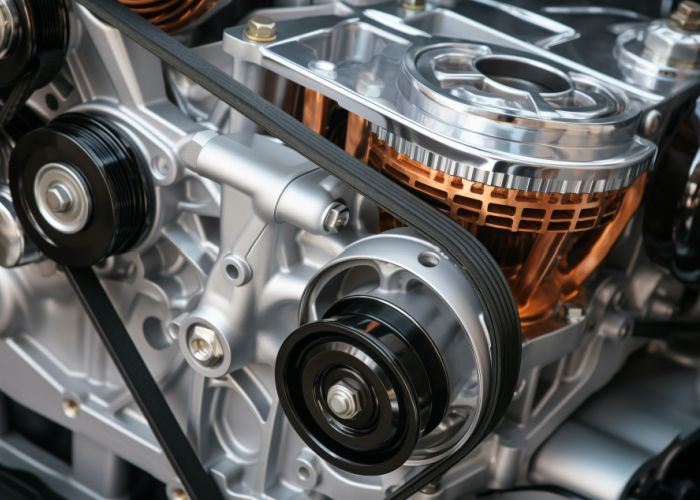Email: enquiry@cksmachining.com Tel: (+86) 18022058253
Hard Coating Anodizing: A Comprehensive Guide to hard anodizing of Aluminum
Surface finishing plays a crucial role in post-processing in manufacturing, aiming to alter the surface of manufactured
parts to achieve specific performance and aesthetic effects.

In CNC machining, anodizing is the most commonly used surface treatment process for aluminum products. Through
anodizing, aluminum not only increases in hardness, corrosion resistance, and aesthetics but also enhances the overall performance of aluminum parts.
This article will detail some characteristics of aluminum hard coating anodizing, exploring the features, processes,
and applications of hard anodizing. We will guide you to understand the differences between hard anodizing and
regular anodizing.
Contents
What is Hard Coating Anodizing?
Aluminum Hard Coating Anodizing Process
Hard Coating Anodizing Standards
Comparison of Hard Anodizing and General anodizing
Application Cases of Hard Coating Anodizing
Hard anodizing case sharing for turbocharger pulley
FAQs How long does hard anodized aluminum last?
What is Hard Coating Anodizing?

Anodizing is an electrochemical process primarily used to form a non-conductive anodized layer on the surface of
non-ferrous metals like aluminum. This process not only enhances the durability of aluminum but also improves
its surface aesthetics and corrosion resistance, making it widely used in various manufacturing industries for CNC
parts.
Hard anodizing, also known as hard coating anodizing, is an advanced form of aluminum anodizing. By forming a
dense anodized aluminum oxide coating on the metal surface through electrolysis, hard anodizing significantly
improves the performance of aluminum, such as wear resistance, corrosion resistance, surface hardness, thermal
insulation,electrical insulation, and sliding properties.
Hard anodization of aluminum Process
The hard anodizing process has significant advantages in cost control and extending the service life of aluminum parts.
Here’s how our engineers handle the parts you need:

Pre-treatment Pre-treatment is the first step in aluminum anodizing. This step involves electrolytic polishing of
aluminum alloy parts in an oxidizing bath, thoroughly cleaning and deoxidizing the surface to remove grease and
surface dirt. This process uses a mixture of phosphoric and nitric acids in an electrolytic bath to produce a near-mirror
finish, making the aluminum surface smoother and cleaner.
Hard Anodizing Process Hard coating anodizing is formed through the electrochemical reaction of aluminum and
oxygen, using sulfuric acid as the electrolyte. The specific steps are as follows:
1.The aluminum part is uniformly fixed on the jig to ensure proper conductivity, then immersed in a sulfuric acid
solution, which contains 180 to 200 grams per liter of acid and a trace amount of dissolved aluminum.
2.Bubbles pass through the acid solution to stir it, keeping the sulfuric acid solution circulating and cool.
3.The sulfuric acid is cooled to near freezing temperatures to ensure the hard anodizing reaction occurs.
4.An electric current of 24 to 40 amps per square foot is applied at a voltage of about 100 volts or more,
generating a measurable oxide film.
5.Conductivity is maintained in the oxidation bath until the desired oxide thickness is achieved, while keeping
the working temperature between -2 and 0°C.
6.The final coating is chemically bonded to the part surface, forming a hard anodized layer.
The thickness of a hard anodizing layer typically ranges from 0.01mm to 0.15mm, depending on the type of
aluminum alloy, but it is worth noting that the thickness of the oxide layer will affect the part's dimensions.
Hard Coating Anodizing Standards
Hard coating anodizing is a widely used surface treatment technology in various industrial fields. To ensure its
consistency, quality, and performance, national standards have been established for hard coating anodizing processes.
These standards cover key performance parameters such as coating thickness, wear resistance, corrosion resistance,
and electrical insulation. Below are some major hard coating anodizing standards:

1.MIL-A-8625, Type III
Overview: MIL-A-8625 is a US military standard that specifies the anodizing treatment of aluminum and aluminum
alloys. Type III refers to hard coating anodizing.
Requirements: This standard specifies the minimum thickness, hardness, corrosion resistance, and wear resistance
of hard coating anodizing. The coating thickness is usually required to be between 25 and 150 microns.
pplications: Widely used in aerospace, defense, and other industries requiring high wear resistance and corrosion
resistance.
2.Aviation MS 2469
Overview: MS 2469 is an aviation industry standard specifying the hard coating anodizing treatment of aviation parts.
Requirements: This standard emphasizes the consistency, wear resistance, and corrosion resistance of the coating and
requires strict quality inspection of treated aluminum parts.
Applications: Mainly used in aerospace parts such as structural components, connectors, and other critical parts to
ensure long-term performance in harsh environments.
3.ASTM B580, Type A
Overview: ASTM B580 is a standard published by the American Society for Testing and Materials, specifying the
anodizing treatment of aluminum and aluminum alloys, including hard coating anodizing.
Requirements: Type A specifies the thickness, hardness, wear resistance, and corrosion resistance of hard coating
anodizing, suitable for industrial applications requiring high wear resistance and corrosion resistance.
Applications: Widely used in surface treatment of mechanical, electronic, and other industrial parts.
4.ISO 10074
Overview: ISO 10074 is a standard published by the International Organization for Standardization, specifying the
hard coating anodizing treatment of aluminum and aluminum alloys.
Requirements: This standard details the process parameters, quality inspection, and performance testing methods
for hard coating anodizing, ensuring the consistency and reliability of the coating.
Applications: Applicable to various industrial applications worldwide, including machinery, electronics, aerospace,
and construction.
5.MIL-A-63576 (PTFE Sealing)
Overview: MIL-A-63576 is a US military standard specifying the hard coating anodizing treated with
polytetrafluoroethylene (PTFE) sealing.
Requirements: This standard requires the coating to have excellent wear resistance, corrosion resistance,
and low friction properties.PTFE sealing further enhances the durability and lubricity of the coating.
Applications: Widely used in military and industrial parts requiring low friction and high wear resistance.
6.AMS 2482 (PTFE Sealing)
Overview: AMS 2482 is an aerospace material specification specifying the hard coating anodizing treated with
PTFE sealing.
Requirements: This standard emphasizes the uniformity, adhesion, and corrosion resistance of the coating and
requires strict quality inspection of treated aluminum parts.
Applications: Mainly used in aerospace and other high-performance industrial parts to ensure long-term use under
demanding conditions.
Hard coating anodizing standards provide clear requirements and guidelines for the surface treatment of aluminum
and aluminum alloy parts.These standards ensure the consistency, durability, and performance of the coatings,
meeting the needs of various industrial applications.
Comparison of Hard Anodizing and General anodizing
In aluminum surface treatment processes, anodizing and hard anodizing are common techniques. Although both
form an oxide layer on the aluminum surface through electrochemical processes, they differ significantly in process,
performance, and applications. Here is a detailed comparison of hard anodizing and general anodizing:

1.Thickness
Hard Anodizing (Type III): Hard anodizing layers are much thicker than general anodizing layers. Hard anodizing
produces coatings typically 12 to 150 microns thick, providing higher hardness, wear resistance, and corrosion
resistance.
General anodizing (Type I and II): Regular anodizing layers are thinner. Type I anodizing thickness is about 2.5
microns, while Type II anodizing thickness ranges from 5 to 15 microns.
2.Sealing
Hard Anodizing: Hard anodizing layers are thicker and denser, usually not sealed, to maintain high wear resistance
and durability. However, specific services may require special sealing treatments to meet customer needs.
General anodizing: Regular anodizing is usually sealed to close surface pores, which helps improve corrosion
resistance and enhances surface aesthetics.
3.Appearance
Hard Anodizing: The surface color after hard anodizing mainly depends on the type of aluminum alloy and the
coating thickness. Hard anodizing layers are typically dark gray or black, with limited color choices, focusing on
functionality.
General anodizing: Regular anodizing (especially Type II) can be dyed in various colors, making it suitable for
decorative applications and popular for aesthetic purposes.
4.Process Parameters
Hard Anodizing: Hard anodizing is typically performed at low temperatures (-2 to 0°C) and high
voltages (over 100 volts), with stricter working conditions than regular anodizing.
General anodizing: Regular anodizing is typically done at room temperature with lower voltage, producing
thinner oxide layers, suitable for decorative and light protective purposes.
5.Applications
Hard Anodizing: Due to its superior wear resistance and hardness, hard anodizing is commonly used in
industrial applications requiring high strength and durability, such as automotive aluminum alloy pulleys.
It is often used for functional parts.
General anodizing: Regular anodizing is widely used for decorative and light protective parts in automotive,
electronics, and consumer goods due to its variety of colors and good corrosion resistance.
6.Performance Characteristics
Hard Anodizing:

Hardness and Wear Resistance: Hard anodized coatings have a hardness of 400 to 600 HV, significantly
better wear resistance than regular anodizing.
Corrosion Resistance: The thick coating provides excellent corrosion resistance.
Electrical Insulation: Hard anodized coatings have high resistivity, offering good electrical insulation.
Heat Resistance: Hard anodized coatings can withstand brief high temperatures up to 2000°C.
General Anodizing:

Aesthetics: The variety of colors makes it suitable for decorative applications.
Light Protection: Offers good corrosion resistance for general applications.
Lower Hardness: Regular anodized coatings are softer than hard anodized coatings.
In conclusion, although both hard anodizing and regular anodizing are used for aluminum surface treatment,
their process parameters, performance characteristics, and applications vary significantly. Hard anodizing offers
better wear resistance, hardness, and durability, suitable for high-performance industrial applications. In contrast,
regular anodizing is mainly used for decorative and light protective purposes.
Application Cases of Hard Coating Anodizing
Hard coating anodizing technology is widely used in various industrial fields, especially in industries requiring high
wear resistance, corrosion resistance, and surface hardness. Below are some specific application cases:
1.Automotive Industry

Engine Components: Hard coating anodizing can be applied to aluminum alloy engine components, such as
pistons, cylinders, and intake manifolds. These components need to withstand high temperatures and friction,
requiring excellent wear resistance and corrosion resistance.
Transmission System Parts: Hard coating anodizing can be applied to aluminum alloy transmission system parts,
such as gearboxes and transmission shafts, improving their surface hardness and wear resistance to ensure
long-term reliability and performance.
Turbine Wheels: Hard coating anodizing can be applied to aluminum alloy turbine wheels, improving their surface
hardness and wear resistance, ensuring their durability and reliability at high speeds and high temperatures.
2.Aerospace Industry

Structural Components: Hard coating anodizing can be applied to aluminum alloy structural components, such
as aircraft frames, wings, and fuselages. These components need to withstand extreme environments and
mechanical stresses, requiring excellent wear resistance and corrosion resistance.
Mechanical Parts: Hard coating anodizing can be applied to aluminum alloy mechanical parts, such as gears,
cams, and valves, improving their surface hardness and wear resistance to ensure their long-term reliability
and performance in high-stress environments.
Connectors and Fasteners: Hard coating anodizing can be applied to aluminum alloy connectors and fasteners,
improving their surface hardness and wear resistance, ensuring their durability and reliability in aerospace
applications.
3.Electronic Industry

Heat Sinks and Housings: Hard coating anodizing can be applied to aluminum alloy heat sinks and housings,
improving their surface hardness and wear resistance, ensuring their durability and reliability in electronic applications.
Connectors and Terminals: Hard coating anodizing can be applied to aluminum alloy connectors and terminals,
improving their surface hardness and wear resistance, ensuring their durability and reliability in electronic applications.
Cooling Components: Hard coating anodizing can be applied to aluminum alloy cooling components, improving
their surface hardness and wear resistance, ensuring their durability and reliability in electronic applications.
4.Machinery Industry

Pulleys and Rollers: Hard coating anodizing can be applied to aluminum alloy pulleys and rollers, improving
their surface hardness and wear resistance, ensuring their durability and reliability in industrial applications.
Gear and Transmission System Parts: Hard coating anodizing can be applied to aluminum alloy gear and
ransmission system parts, improving their surface hardness and wear resistance, ensuring their long-term
reliability and performance.
Cutting Tools and Molds: Hard coating anodizing can be applied to aluminum alloy cutting tools and molds,
improving their surface hardness and wear resistance, ensuring their durability and reliability in high-stress
environments.
Hard anodizing case sharing for turbocharger pulley
Case Study: Turbocharger Pulley Application of Hard Anodizing The turbocharger pulley is a critical component of the
automobile engine, subjected to high speeds and temperatures, requiring high wear and heat resistance. Hard anodizing
performs exceptionally well under these high-load conditions.

•Process Selection: Hard Anodizing
•Process Parameters: Conducted at low temperatures to form an oxide layer thickness ranging from 50 to 150 micrometers.
•Performance Enhancement: Post hard anodizing, the surface hardness of the turbocharger pulley reaches up to 600 HV, significantly improving wear resistance and enabling stable operation under high-speed and high-temperature conditions.
Thermal resistance is also greatly enhanced to withstand the high temperatures during engine operation.
Limitations of Conventional Anodizing If conventional anodizing is used, due to its thinner and less hard coating, the
turbocharger pulley cannot withstand prolonged operation under high speeds and temperatures, leading to wear and
deformation, thus affecting engine performance and lifespan.
Case Summary From the above cases, it is evident that both hard anodizing and conventional anodizing have their
advantages and specific applications. Hard anodizing, with its outstanding wear and corrosion resistance, is suitable for
critical automotive components requiring high strength and durability, such as engine pistons and turbocharger pulleys.
On the other hand, conventional anodizing, with its variety of colors and smooth surface, is suitable for parts emphasizing appearance and decoration, such as body trims.
Understanding the characteristics of these two anodizing processes helps manufacturers make the best choices during the
design and production phases.
FAQs How long does hard anodized aluminum last?
Hard anodized aluminum parts are extremely durable and can remain intact under normal conditions. However, the
lifespan of hard anodized aluminum parts typically ranges from three to five years if surface wear begins. Therefore,
damaged oxide layers need regular maintenance or re-anodizing to ensure proper functionality.
What is the thickness of the coating on hard anodized aluminum?
The coating thickness of hard anodized aluminum depends on the type of aluminum alloy and process parameters.
Typically, without anodizing, aluminum alloys will be severely corroded, and the hard coating anodizing process can
increase the coating thickness to 13 to 150 micrometers, providing better wear and corrosion resistance for aluminum
parts.
Is sealing necessary for hard anodizing?
The application of hard anodized aluminum determines whether sealing is necessary. For parts requiring wear resistance,
sealing is generally avoided to maintain durability and wear resistance. However, for parts requiring additional corrosion resistance, sealing is essential. Sealing enhances surface protection by preventing contaminants from entering the anodic
layer pores.
What are the main applications of hard anodizing?
Hard anodizing is widely used for various parts requiring high strength and wear resistance, primarily in functional
products. These applications include:
Can the color of hard anodizing be changed?
Hard anodized aluminum typically exhibits colors like deep gray or black. Unlike conventional anodizing, hard anodizing
offers fewer color choices, but its durability and performance advantages compensate for this limitation.
Is hard anodizing more expensive than regular anodizing?
Due to its demanding oxidation conditions, special processes, added chemicals, and processing time, hard anodizing
generally incurs slightly higher costs compared to regular anodizing.
Does hard anodizing affect the environment?
The hard anodizing process involves chemicals and electrolytes, but waste and emissions can typically be managed and
reduced through proper waste disposal and environmental measures. With increasing environmental regulations, modern anodizing processes are continuously improving to minimize their environmental impact.
These FAQs aim to help you better understand the various details and applications of hard anodizing. If you have more
questions or need further assistance, please feel free to contact our professional team at any time.